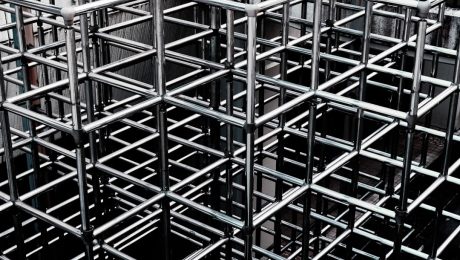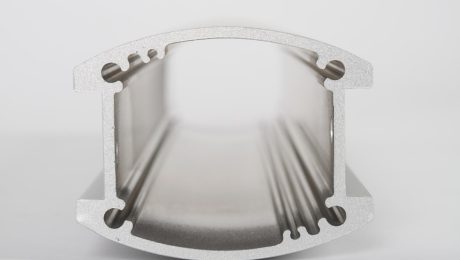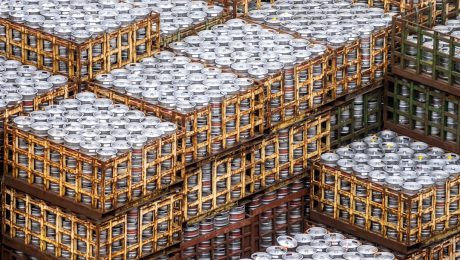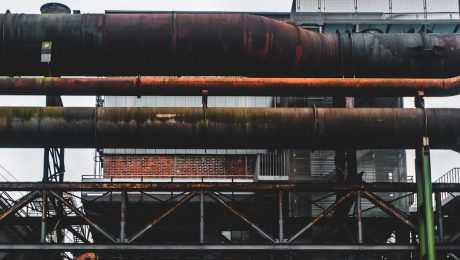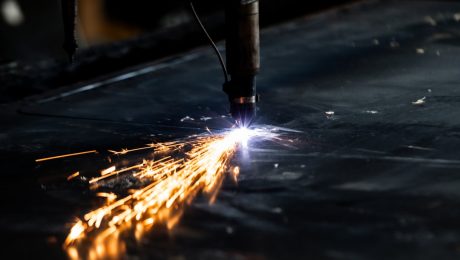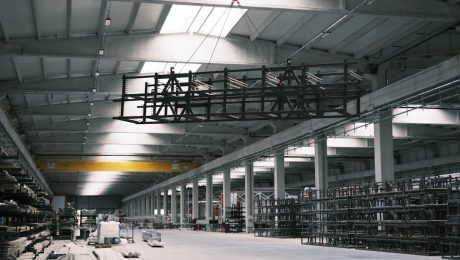Prefabricated steel structures are revolutionizing the construction industry, offering a faster, more efficient, and cost-effective alternative to traditional building methods. This comprehensive guide delves into the world of prefabricated steel, exploring its advantages, design considerations, diverse applications, and the exciting future it holds.
The Advantages of Prefabricated Steel Structures
Prefabricated steel structures boast a multitude of advantages over conventional construction techniques. The most significant benefits include:
- Speed and Efficiency: Fabrication occurs off-site in a controlled environment, significantly reducing construction time. Components are pre-engineered and manufactured to precise specifications, minimizing on-site delays and errors.
- Cost-Effectiveness: While initial material costs might seem higher, the reduced labor costs, faster construction timelines, and minimized waste contribute to overall project cost savings.
- Durability and Strength: Steel is incredibly strong and durable, capable of withstanding extreme weather conditions and providing excellent resistance to fire and pests. This translates to a longer lifespan and reduced maintenance requirements.
- Flexibility and Design Options: Steel’s versatility allows for a wide range of architectural designs and complex geometries. It can be easily shaped and customized to meet specific project needs.
- Sustainability: Steel is a highly recyclable material, contributing to environmentally friendly construction practices. Prefabrication also minimizes on-site waste and reduces the carbon footprint associated with transportation.
Design and Engineering of Prefabricated Steel Structures
The design and engineering process for prefabricated steel structures is meticulous and involves several key steps:
- Conceptual Design: Architects and engineers collaborate to develop a detailed design based on the client’s requirements and site conditions.
- Structural Analysis: Sophisticated software is used to analyze the structural integrity of the design, ensuring it can withstand anticipated loads and stresses.
- Fabrication Drawings: Detailed fabrication drawings are created, specifying the dimensions, connections, and other critical aspects of each steel component.
- Manufacturing: Steel components are manufactured off-site in a controlled factory environment using advanced technologies like CNC machining.
- On-Site Assembly: Pre-fabricated components are transported to the construction site and assembled efficiently, often using specialized cranes and lifting equipment.
This precise and controlled process minimizes errors and ensures the final structure meets the highest quality standards.
Applications of Prefabricated Steel Structures
The versatility of prefabricated steel structures makes them suitable for a wide range of applications, including:
- Industrial Buildings: Warehouses, factories, and manufacturing plants benefit from the strength, durability, and speed of construction offered by steel.
- Commercial Buildings: Office buildings, retail spaces, and shopping malls can be efficiently constructed using prefabricated steel, offering flexibility in design and layout.
- Residential Buildings: Prefabricated steel is increasingly used in residential construction, offering a cost-effective and sustainable solution for homes and apartments.
- Agricultural Buildings: Steel structures are ideal for barns, sheds, and other agricultural facilities, providing durable and weather-resistant solutions.
- Infrastructure Projects: Bridges, towers, and other infrastructure projects can leverage the strength and longevity of prefabricated steel components.
Cost Analysis of Prefabricated Steel Construction
While the initial material cost of steel might be higher than some traditional materials, the overall cost-effectiveness of prefabricated steel structures is undeniable. Factors contributing to cost savings include:
- Reduced Labor Costs: Less on-site labor is required due to the off-site fabrication and efficient assembly process.
- Faster Construction Timelines: Shorter construction periods lead to reduced project financing costs and faster return on investment.
- Minimized Waste: Precise manufacturing minimizes material waste, leading to lower disposal costs.
- Lower Maintenance Costs: The durability and longevity of steel structures translate to reduced maintenance and repair expenses over the building’s lifespan.
A thorough cost analysis comparing prefabricated steel with traditional construction methods is crucial for determining the overall economic viability of a project.
Future Trends in Prefabricated Steel Structures
The future of prefabricated steel structures is bright, with ongoing innovations driving further advancements. Key trends include:
- Increased Automation: Further automation in the manufacturing process will improve efficiency and reduce costs.
- Sustainable Practices: Emphasis on using recycled steel and incorporating sustainable design principles will become even more prominent.
- Modular Design: Modular construction using prefabricated steel components will allow for greater flexibility and customization.
- Advanced Materials: Integration of advanced materials and technologies will enhance the performance and longevity of steel structures.
- Digitalization: Building Information Modeling (BIM) and other digital tools will continue to optimize the design, fabrication, and construction processes.
Prefabricated steel structures are poised to play an increasingly significant role in shaping the built environment, offering sustainable, efficient, and cost-effective solutions for a wide range of construction projects.
body { font-family: sans-serif; line-height: 1.6; }
img { max-width: 100%; height: auto; display: block; margin: 20px auto; }
h1, h2, h3 { color: #333; }
Steel. The very word conjures images of strength, resilience, and enduring power. But beyond its inherent properties lies a world of astonishing versatility. This visual gallery explores the myriad ways steel shapes our world, from the towering skyscrapers that pierce the sky to the intricate components within our everyday devices. Prepare to be amazed by the sheer scope of steel’s applications.
1. Steel in Construction: Skyscrapers and Beyond

Steel’s high tensile strength and adaptability make it the backbone of modern construction. From the iconic Eiffel Tower to the breathtaking Burj Khalifa, steel frameworks provide the structural integrity needed for towering skyscrapers. But its role extends far beyond these monumental structures. Steel is crucial in the construction of bridges, stadiums, high-rise buildings, and even smaller residential structures. Its ability to be easily formed and welded allows for complex designs and efficient construction processes. The image above showcases a modern skyscraper, a testament to steel’s ability to reach for the sky. Furthermore, steel’s durability ensures long-lasting structures, minimizing maintenance and maximizing lifespan.
2. Steel in Infrastructure: Roads, Bridges, and Railways

Our global infrastructure relies heavily on steel. Steel beams, girders, and rails form the foundation of our road networks, railway systems, and bridges. The strength and durability of steel ensure that these crucial arteries of transport can withstand heavy loads and harsh weather conditions. Steel’s resistance to corrosion, when properly treated, further extends the lifespan of these structures, saving time and resources on repairs and replacements. The image above shows a robust steel bridge, a critical component of our transportation infrastructure. The use of steel allows for the construction of long spans and complex designs, connecting communities and facilitating trade.
3. Steel in Manufacturing: From Cars to Appliances

Steel’s malleability and strength are essential in manufacturing a vast array of products. The automotive industry is a prime example, with steel forming the chassis, body panels, and numerous internal components of vehicles. Beyond automobiles, steel is used in the production of appliances, machinery, tools, and countless other manufactured goods. Its ability to be easily shaped, stamped, and formed allows for mass production and cost-effective manufacturing processes. The image above depicts a car manufacturing plant, showcasing the scale of steel’s use in this industry. Steel’s versatility ensures that products are both durable and affordable.
4. Steel in Energy: Power Generation and Transmission

The energy sector is increasingly reliant on steel. Wind turbines, a key component of renewable energy generation, utilize steel for their towers, blades, and supporting structures. Steel’s strength allows these turbines to withstand the immense forces of wind, ensuring efficient and reliable energy production. Furthermore, steel plays a crucial role in the construction and maintenance of power plants, transmission lines, and pipelines. Its durability and resistance to extreme temperatures make it ideal for these demanding applications. The image above showcases a wind turbine, a prime example of steel’s contribution to renewable energy.
5. Steel in Specialized Applications: Medical, Aerospace, and More

Steel’s applications extend beyond the commonly known uses. In the medical field, stainless steel is used in the creation of surgical instruments, implants, and medical equipment due to its biocompatibility and resistance to corrosion. The aerospace industry utilizes high-strength steel alloys for critical components of aircraft and spacecraft, demanding exceptional strength and lightweight properties. Other specialized applications include the construction of oil rigs, pipelines, and even artistic sculptures. Steel’s adaptability allows it to meet the unique demands of diverse industries, constantly pushing the boundaries of innovation. The image above displays medical equipment, highlighting steel’s crucial role in healthcare.
This visual gallery only scratches the surface of steel’s vast applications. Its enduring strength, versatility, and recyclability solidify its position as a fundamental material in shaping our modern world. As technology advances, we can expect even more innovative uses of this remarkable metal.
SEO-Friendly Tags:
- Steel Applications
- Steel Uses
- Industrial Steel
- Construction Steel
- Steel in Infrastructure
“`
Remember to replace the placeholder image URLs (`placeholder_skyscraper.jpg`, `placeholder_bridge.jpg`, etc.) with actual image URLs. You’ll also want to optimize the images for web use to ensure fast loading times.
The phrase “000 ton/year production capacity” represents a significant milestone for any manufacturing or production enterprise. While the specific number ‘000’ needs to be replaced with the actual figure, the underlying principles and considerations remain the same. This post delves into the multifaceted aspects of achieving and managing such a substantial production capacity, exploring the challenges, opportunities, and strategic implications involved.
1. Defining and Assessing 000 Ton/Year Production Capacity
Before diving into the specifics, it’s crucial to define what “000 ton/year production capacity” truly means. This figure represents the maximum amount of a particular product (measured in tons) that a facility can produce within a year, operating under optimal conditions. Optimal conditions include factors like efficient equipment utilization, skilled labor, readily available raw materials, and minimal downtime. Assessing this capacity requires a thorough analysis of several key areas:
- Equipment Capacity: Determining the individual and combined output of all production machinery and equipment is paramount. This involves analyzing machine efficiency, potential bottlenecks, and planned maintenance schedules.
- Labor Capacity: The number of skilled workers, their productivity levels, and the efficiency of the production process directly impact capacity. Skill gaps and training needs should be factored into the assessment.
- Raw Material Availability: Securing a consistent and reliable supply of raw materials is critical. Potential supply chain disruptions and their impact on production should be considered.
- Storage and Logistics: Efficient storage facilities and a well-planned logistics network are vital for handling the large volume of goods produced. Capacity limitations in these areas can severely restrict overall production.
2. Scaling Up to 000 Ton/Year: The Challenges of Expansion
Achieving a production capacity of 000 tons per year often involves significant expansion. This scaling-up process presents numerous challenges:
- Capital Investment: Expanding production capacity demands substantial investment in new equipment, facilities, and infrastructure. Securing funding and managing the financial risks associated with such a large investment is crucial.
- Operational Efficiency: Maintaining operational efficiency as the production scale increases is a major hurdle. This requires robust process optimization, effective inventory management, and seamless integration of new equipment and processes.
- Human Resources: Finding, training, and retaining skilled labor to manage the expanded operations is essential. This may involve recruitment drives, training programs, and strategies to improve employee retention.
- Supply Chain Management: As production volume increases, so does the demand for raw materials and logistics services. Ensuring a reliable and cost-effective supply chain is vital to avoid production delays and disruptions.
- Regulatory Compliance: Expanding operations may necessitate navigating complex regulatory requirements and obtaining necessary permits and licenses. This often involves significant legal and administrative efforts.
3. Market Considerations for a 000 Ton/Year Production Capacity
A production capacity of this magnitude necessitates a thorough understanding of the market. Simply producing a large quantity of goods doesn’t guarantee success; there must be sufficient demand to absorb the output:
- Market Demand Analysis: A comprehensive market analysis is essential to assess the current and projected demand for the product. This involves identifying target markets, analyzing competitor activity, and forecasting future trends.
- Pricing Strategies: Determining optimal pricing strategies to maximize profitability while remaining competitive is critical. This requires careful consideration of production costs, market prices, and customer demand elasticity.
- Distribution and Sales Channels: Establishing efficient and effective distribution and sales channels is crucial to reach target markets and sell the large volume of goods produced. This might involve expanding existing channels or developing new ones.
- Marketing and Branding: Effective marketing and branding strategies are necessary to build brand awareness, create customer loyalty, and drive sales. This is particularly important when entering new markets or competing against established brands.
4. Technological Advancements and 000 Ton/Year Production
Technological advancements play a pivotal role in achieving and managing a high production capacity. Automation, advanced analytics, and Industry 4.0 technologies offer significant opportunities for increased efficiency and reduced costs:
- Automation: Automating various stages of the production process can significantly improve efficiency, reduce labor costs, and minimize errors. Robotics, automated guided vehicles (AGVs), and other automation technologies can be integrated to streamline operations.
- Data Analytics: Analyzing production data using advanced analytics can identify bottlenecks, predict equipment failures, and optimize production processes. This data-driven approach enables proactive decision-making and continuous improvement.
- Industry 4.0 Technologies: Implementing Industry 4.0 technologies, such as the Industrial Internet of Things (IIoT) and cloud computing, can enhance connectivity, improve data visibility, and facilitate real-time monitoring and control of the production process.
5. Sustainability and Environmental Impact of High-Volume Production
Producing 000 tons of a product annually has significant environmental implications. Addressing these concerns is crucial for long-term sustainability and responsible business practices:
- Resource Efficiency: Minimizing resource consumption (water, energy, raw materials) throughout the production process is essential. This can involve implementing energy-efficient equipment, optimizing material usage, and adopting circular economy principles.
- Waste Management: Implementing effective waste management strategies to reduce, reuse, and recycle waste generated during production is crucial. This minimizes environmental impact and can potentially generate revenue from recycled materials.
- Emissions Reduction: Reducing greenhouse gas emissions and other pollutants generated during production is essential. This may involve investing in cleaner technologies, improving energy efficiency, and adopting carbon offsetting strategies.
- Compliance with Environmental Regulations: Adhering to all relevant environmental regulations and obtaining necessary permits is crucial to avoid legal penalties and maintain a positive corporate social responsibility profile.
In conclusion, achieving and maintaining a 000 ton/year production capacity requires a multifaceted approach encompassing meticulous planning, significant investment, technological integration, and a deep understanding of market dynamics and environmental responsibilities. Success relies on effectively addressing the challenges and capitalizing on the opportunities presented by this ambitious production scale.
Tags: Production Capacity, Manufacturing, Scaling Production, Market Demand, Sustainability, Industrial Automation, Supply Chain Management
“`
Remember to replace “000” with the actual tonnage figure throughout the HTML.
BrightWire is a powerful, open-source machine learning library designed to simplify the development and deployment of neural networks. It offers a range of features that make it a compelling choice for both beginners and experienced developers. This comprehensive guide delves into the core functionalities of BrightWire, showcasing its capabilities and demonstrating its potential for various machine learning tasks.
1. Streamlined Neural Network Creation: Building Blocks for Complex Architectures
BrightWire excels at simplifying the process of creating neural networks. Instead of wrestling with low-level matrix operations, BrightWire provides a high-level, intuitive API. You can construct complex architectures – from simple feedforward networks to intricate recurrent and convolutional neural networks – with minimal code. Its modular design allows you to easily combine different layers, activation functions, and optimizers to tailor your network to specific needs. This streamlined approach significantly reduces development time and allows you to focus on the core aspects of your machine learning project rather than getting bogged down in implementation details. For example, creating a simple feedforward network with BrightWire might involve only a few lines of code, compared to significantly more complex code in other libraries.
2. Diverse Layer Support: From Basic to Advanced Network Components
BrightWire boasts a comprehensive collection of neural network layers. This includes fundamental layers such as fully connected, convolutional, and recurrent layers, but it also extends to more specialized layers like LSTM (Long Short-Term Memory) and GRU (Gated Recurrent Unit) layers for handling sequential data, and various pooling layers for convolutional networks. The availability of these diverse layers allows for the construction of highly sophisticated models capable of tackling a wide variety of machine learning problems. The library’s well-documented API makes it straightforward to understand and utilize these layers effectively, regardless of your experience level.
3. Optimized Training Algorithms: Accelerating Model Convergence
Efficient training is crucial for successful machine learning. BrightWire incorporates a selection of optimized training algorithms, including stochastic gradient descent (SGD) and its variants (like Adam, RMSProp, and AdaGrad). These algorithms are carefully implemented for performance, ensuring efficient model training, even with large datasets. The library allows for easy switching between different optimizers, enabling experimentation and fine-tuning to find the best approach for a particular problem. Furthermore, BrightWire provides tools for monitoring the training process, allowing you to track metrics such as loss and accuracy to gauge the progress and effectiveness of your chosen optimizer.
4. Flexible Data Handling: Adapting to Diverse Input Formats
BrightWire is designed to handle various data formats, making it adaptable to a wide range of machine learning tasks. It supports both numerical and categorical data, and it can efficiently process data from different sources, including CSV files, databases, and custom data structures. The library provides tools for data preprocessing, such as normalization and standardization, which are essential steps in preparing data for effective model training. This flexibility ensures that BrightWire can be integrated seamlessly into existing workflows and handle diverse datasets without requiring significant modifications.
5. Deployment and Integration: Seamless Transition from Development to Production
BrightWire isn’t just for prototyping; it’s designed for deployment. While the library simplifies development, it also facilitates the transition to production environments. Its efficient implementation ensures that trained models can be deployed effectively, minimizing latency and resource consumption. The library’s modular architecture makes it easy to integrate into various applications and systems, allowing you to seamlessly incorporate your machine learning models into larger projects. This focus on deployment-readiness makes BrightWire a practical choice for real-world applications, not just academic research.
In conclusion, BrightWire’s combination of streamlined development, diverse layer support, optimized training algorithms, flexible data handling, and deployment capabilities makes it a powerful and versatile tool for machine learning. Its intuitive API and well-documented features make it accessible to a broad range of users, from students to experienced data scientists.
SEO-Friendly Tags:
- BrightWire
- Machine Learning Library
- Neural Network Framework
- Deep Learning Library
- AI Development
Oil refineries are complex, high-pressure environments where the efficient and safe transport of various hydrocarbons is paramount. At the heart of this intricate network lies a seemingly simple yet crucial component: the steel pipe. From transporting raw crude oil to delivering refined products, steel pipes form the very arteries of a refinery, demanding robust construction, meticulous selection, and rigorous maintenance.
Diverse Applications of Steel Pipes in Oil Refineries
Steel pipes in refineries serve a multitude of critical functions, each requiring specific properties and design considerations. They are used extensively in:
- Crude Oil Transfer: Large-diameter steel pipes transport raw crude oil from storage tanks to the initial processing units. These pipes must withstand high volumes and potentially corrosive elements present in crude oil.
- Process Piping: Smaller diameter pipes are used extensively within the refinery process units, transporting intermediate products between various stages of refining. These pipes often operate under high pressure and temperature, requiring specialized alloys.
- Product Transfer: After processing, refined products like gasoline, diesel, and jet fuel are transported via steel pipelines to storage tanks and distribution points. The specific requirements for these pipes vary depending on the product.
- Steam and Water Lines: Steam and water are essential utilities in a refinery. Steel pipes are crucial for efficiently distributing these fluids throughout the facility. These pipes require resistance to high temperatures and potential water hammer.
- Instrument and Control Lines: Smaller diameter pipes are used for instrumentation and control systems, carrying gases, liquids, and signals to various sensors and actuators. Accuracy and reliability are paramount here.
Material Selection: Choosing the Right Steel for the Job
The choice of steel pipe depends heavily on the specific application and the operating conditions. Several factors influence material selection:
- Pressure and Temperature: High-pressure and high-temperature applications require stronger, more heat-resistant steels, such as various grades of alloy steel. Carbon steel is suitable for lower pressure and temperature applications.
- Corrosion Resistance: Many refinery processes involve corrosive substances. Stainless steel or other corrosion-resistant alloys might be necessary to prevent pipe degradation and leaks. Specialized coatings may also be applied.
- Weldability: The ability to weld the pipes securely is crucial. The chosen steel grade must be readily weldable using appropriate techniques to ensure structural integrity.
- Cost Considerations: While performance is a primary concern, cost-effectiveness is also a factor. The optimal steel grade balances performance requirements with economic viability.
- Industry Standards: Pipe selection must comply with relevant industry standards and regulations, such as those set by ASME (American Society of Mechanical Engineers) and API (American Petroleum Institute).
Safety Considerations and Regulatory Compliance
Safety is paramount in oil refineries. Steel pipe integrity is crucial to preventing catastrophic incidents. Strict adherence to safety protocols and regulations is non-negotiable:
- Regular Inspections: Pipelines undergo regular inspections, including visual checks, pressure testing, and non-destructive testing (NDT) methods like ultrasonic testing and radiographic testing to detect flaws.
- Leak Detection Systems: Sophisticated leak detection systems are employed to quickly identify and address any leaks, minimizing environmental damage and safety risks.
- Emergency Shutdown Systems: Emergency shutdown systems are in place to rapidly isolate sections of the pipeline in case of leaks or other emergencies.
- Proper Installation and Welding: Correct installation and welding techniques are essential to ensure the integrity of the pipeline system. Qualified welders and rigorous quality control are crucial.
- Compliance with Standards: All aspects of steel pipe selection, installation, and maintenance must comply with relevant industry standards and regulatory requirements to ensure safe operation.
Maintenance and Repair Strategies for Optimal Performance
Regular maintenance is essential to extend the lifespan of steel pipes and prevent failures. A proactive approach to maintenance is far more cost-effective than reactive repairs:
- Preventive Maintenance: Scheduled inspections, cleaning, and internal/external coatings are part of a robust preventive maintenance program.
- Corrosion Control: Implementing corrosion control measures, such as cathodic protection, is vital in combating corrosion and extending pipe life.
- Repair Techniques: Various repair techniques exist, from simple patching to more complex repairs involving pipe replacement. The choice depends on the severity of the damage.
- Data-Driven Maintenance: Utilizing data from sensors and monitoring systems can help predict potential failures and schedule maintenance proactively.
- Specialized Expertise: Refinery maintenance requires specialized expertise and skilled personnel to handle the complex systems and potentially hazardous materials.
The Future of Steel Pipes in Oil Refineries
The oil and gas industry is constantly evolving, and the use of steel pipes is no exception. Advancements in materials science, manufacturing techniques, and data analytics are leading to improvements in pipeline design, construction, and maintenance. The future likely involves:
- Advanced Materials: The development of new steel alloys with enhanced corrosion resistance and strength will continue to improve pipeline performance.
- Smart Pipes: Incorporating sensors and monitoring systems into pipelines allows for real-time monitoring of pressure, temperature, and other parameters, enabling predictive maintenance.
- Improved Welding Techniques: Advancements in welding technology will improve the quality and efficiency of pipe joining, enhancing overall pipeline integrity.
- Sustainable Practices: The industry is increasingly focused on sustainability, and this will drive the adoption of more environmentally friendly materials and practices in pipeline management.
- Digital Twin Technology: Creating digital twins of refinery pipeline systems allows for virtual testing and optimization of maintenance strategies, improving efficiency and reducing downtime.
In conclusion, steel pipes are indispensable to the safe and efficient operation of oil refineries. Understanding their diverse applications, material selection criteria, safety considerations, and maintenance strategies is crucial for ensuring the longevity and reliability of these critical components within the complex refinery environment.
Tags: steel pipes, oil refinery, refinery pipes, carbon steel pipes, alloy steel pipes
The steel industry, a cornerstone of global infrastructure and manufacturing, is undergoing a dramatic transformation fueled by relentless research and development (R&D). Innovation in steel isn’t just about producing more; it’s about producing better – stronger, lighter, more sustainable, and more versatile materials tailored to the specific demands of emerging technologies and a changing world. This post delves into the fascinating world of R&D in steel product innovation, exploring the key areas driving progress and the transformative impact on various sectors.
1. Advanced Alloying and Microstructural Control: The Foundation of Steel Innovation
The quest for superior steel begins at the atomic level. Advanced alloying techniques are revolutionizing steel properties. By carefully controlling the composition and distribution of alloying elements (such as chromium, nickel, molybdenum, vanadium, and manganese), researchers are achieving unprecedented levels of strength, toughness, corrosion resistance, and high-temperature performance. Techniques like thermo-mechanical processing (TMP) are crucial, allowing for precise manipulation of the steel’s microstructure, creating tailored grain sizes and orientations to optimize desired properties. This precision engineering leads to high-performance steels used in demanding applications like aerospace, automotive, and energy infrastructure.
2. Sustainable Steel Production: Minimizing Environmental Impact
The environmental footprint of steel production is a significant concern. R&D is focused on developing more sustainable manufacturing processes to reduce greenhouse gas emissions and resource consumption. This includes exploring alternative energy sources for steelmaking, such as hydrogen-based reduction, which eliminates the need for coal and significantly reduces CO2 emissions. Efforts are also underway to improve energy efficiency in existing processes and develop techniques for recycling and reusing steel scrap, creating a circular economy for steel. The development of green steel is not just an environmental imperative; it’s a strategic move to ensure the long-term viability and competitiveness of the industry.
3. Additive Manufacturing of Steel: Revolutionizing Design and Production
Additive manufacturing, or 3D printing, is transforming the way steel components are designed and manufactured. This technology allows for the creation of complex geometries and intricate designs that are impossible to achieve with traditional methods. This opens up opportunities for lightweighting, improved performance, and reduced material waste. While still in its early stages for steel, significant advancements are being made in powder metallurgy and laser-based techniques, paving the way for wider adoption in various industries. The ability to produce customized steel components on demand is a game-changer for prototyping, small-batch production, and specialized applications.
4. High-Strength Steels for Lightweighting Applications
The automotive and aerospace industries are driving demand for high-strength, lightweight steels. These materials offer significant fuel efficiency benefits and reduced emissions. Advanced high-strength steels (AHSS) and ultra-high-strength steels (UHSS) are at the forefront of this development. These steels achieve exceptional strength-to-weight ratios through advanced microstructural control and alloying techniques. This allows for the design of lighter vehicles and aircraft, leading to improved fuel economy and reduced environmental impact. Research is continually pushing the boundaries of strength and formability, enabling more complex designs and further weight reduction.
5. Smart Steels and Advanced Sensors: Integrating Intelligence into Steel Structures
The integration of sensors and smart materials is leading to the development of “smart steels.” These materials can monitor their own structural health, providing real-time data on stress, strain, and potential damage. This capability is particularly valuable in critical infrastructure, such as bridges, buildings, and pipelines, enabling proactive maintenance and preventing catastrophic failures. Researchers are exploring various methods for embedding sensors within steel components, developing self-healing capabilities, and integrating data analytics to interpret the sensor data and provide actionable insights. This technology promises to enhance safety, reliability, and longevity of steel structures.
The future of steel is bright, driven by the continuous pursuit of innovation through rigorous R&D. The advancements discussed here are just a glimpse into the transformative potential of this critical material. As research continues, we can expect even more groundbreaking developments, shaping a future built on stronger, lighter, smarter, and more sustainable steel.
SEO-Friendly Tags:
- Steel Innovation
- R&D Steel
- Advanced Steel Materials
- Sustainable Steel Production
- High-Strength Steel Applications
Post-production is the crucial final stage where your creative vision transforms into a polished, ready-to-release product. But even the most brilliant creative work can be undermined by overlooked errors or inconsistencies. That’s where meticulous post-production quality monitoring (PQM) comes in. This comprehensive guide will explore the vital aspects of PQM, enabling you to deliver high-quality content consistently.
1. Defining Clear Quality Standards: The Foundation of Effective PQM
Before you even begin the post-production process, establishing clear and specific quality standards is paramount. These standards should encompass every aspect of your project, from technical specifications (resolution, frame rate, audio levels) to stylistic elements (color grading consistency, visual effects quality, narrative flow). Consider creating a detailed checklist outlining acceptable and unacceptable levels for each parameter. This checklist should be readily accessible to your entire post-production team and regularly reviewed and updated to reflect evolving project needs and technological advancements.
For example, your standards might include specific tolerances for audio hiss, color banding, or motion blur. Clearly defined thresholds allow for objective assessment, minimizing subjective interpretation and ensuring consistent application across different team members and projects. This proactive approach minimizes costly rework and ensures a smoother, more efficient post-production workflow.
2. Streamlining Your Post-Production Workflow for Efficient Quality Control
An efficient workflow is the backbone of effective PQM. A disorganized process leads to errors, delays, and inconsistencies. Implementing a structured workflow that incorporates quality checks at every stage is critical. This could involve incorporating regular QC checkpoints throughout the editing process, ensuring that each stage of production meets the pre-defined standards before moving to the next. This could include daily or weekly reviews of footage, sound design, and visual effects.
Consider using project management software to track progress, assign tasks, and manage revisions. This centralized system provides transparency and accountability, facilitating better communication and collaboration among team members. Clearly defined roles and responsibilities within the workflow further contribute to efficiency and consistency in quality control.
3. Leveraging Automated Quality Control Tools: Speed and Accuracy
Manual quality control can be time-consuming and prone to human error. Fortunately, numerous automated QC tools are available to significantly improve efficiency and accuracy. These tools can automatically scan footage for technical issues such as dropped frames, interlacing problems, audio glitches, and color inconsistencies. They often provide detailed reports highlighting specific problems and their locations within the project, allowing for targeted corrections.
Investing in such software can significantly reduce the time spent on manual checks, allowing your team to focus on more creative aspects of the post-production process. The objective nature of automated tools also minimizes subjective bias, ensuring consistent application of quality standards across all projects. This combination of speed and accuracy is crucial for maintaining high production values while meeting tight deadlines.
4. Ensuring Consistent Quality Across Multiple Projects and Team Members
Maintaining consistent quality across different projects and team members is a significant challenge. To achieve this, standardized procedures, training, and regular communication are essential. Ensure that all team members understand and adhere to the established quality standards and workflows. Regular training sessions can help reinforce these standards and address any ambiguities. This includes providing clear guidelines on the use of software and hardware, as well as best practices for various tasks.
Implementing a system for feedback and review is crucial. Regular team meetings can be used to discuss quality control issues, share best practices, and address any inconsistencies. A centralized repository for quality control documentation, including checklists, templates, and training materials, ensures easy access and consistency across all projects. This consistent approach to quality management fosters a culture of excellence throughout the post-production process.
5. Post-Production Quality Monitoring: Continuous Improvement
Post-production quality monitoring is not a one-time process; it’s an ongoing cycle of improvement. Regularly analyze the results of your quality control efforts to identify areas for improvement in your workflows, standards, and tools. Track the types of errors that occur most frequently and investigate their root causes. This data-driven approach allows for targeted improvements, leading to increased efficiency and higher quality output.
Gathering feedback from clients and internal stakeholders is equally important. Their insights can reveal areas where your quality standards might need adjustment or where your workflows could be optimized. By embracing a culture of continuous improvement, you can continuously enhance your post-production quality monitoring process, ensuring that your final product consistently meets and exceeds expectations.
By implementing these strategies, you can effectively manage and improve the quality of your post-production work, delivering exceptional results every time.
SEO Tags:
- Post-Production Quality Control
- Video Post-Production QC
- Automated QC Software
- Post-Production Workflow
- Film Quality Assurance
The Hot Rolling Process: From Ingot to Flat Bar
Hot rolled flat bars begin their journey as a molten metal ingot, typically steel. This ingot undergoes a series of rigorous processes to achieve its final form. First, it’s heated to an incredibly high temperature, often exceeding 1100°C (2012°F), making the metal highly malleable. This high temperature allows for significant deformation without fracturing. Then, the glowing ingot is passed through a series of powerful rollers, progressively reducing its thickness and shaping it into a flat bar. The rollers are precisely calibrated to control the dimensions and tolerances of the final product. This continuous rolling process refines the grain structure of the metal, impacting its final strength and other properties. The entire process is carefully monitored to ensure consistency and quality.
Mechanical Properties and Characteristics of Hot Rolled Flat Bars
The hot rolling process significantly influences the mechanical properties of the resulting flat bars. Due to the high temperatures involved, the material undergoes significant grain growth. This leads to a relatively lower tensile strength compared to cold-rolled counterparts. However, hot-rolled bars possess superior ductility and toughness, meaning they can withstand significant deformation before fracturing and are less prone to brittle failure. Their surface finish is generally rougher than cold-rolled bars, a characteristic resulting from the high-temperature deformation. The precise mechanical properties, such as yield strength, tensile strength, elongation, and hardness, vary depending on the alloying elements present in the steel and the specific rolling parameters used. These properties are crucial considerations when selecting the appropriate material for a particular application.
Diverse Applications of Hot Rolled Flat Bars
The versatility of hot rolled flat bars makes them suitable for a wide array of applications across various industries. Their excellent weldability, high ductility, and relatively low cost make them a popular choice for structural components in construction, such as beams, columns, and reinforcement bars. They’re also frequently used in the manufacturing of automotive parts, railway components, and heavy machinery. Other applications include fabrication of agricultural equipment, industrial machinery, and general engineering projects. The specific application often dictates the required grade and dimensions of the flat bar, ensuring optimal performance and longevity.
Advantages and Disadvantages of Hot Rolled Flat Bars
Advantages: The primary advantage of hot-rolled flat bars lies in their cost-effectiveness. The high-temperature rolling process is relatively efficient and requires less energy compared to cold rolling. This translates into lower production costs, making them a budget-friendly option for many applications. Their superior ductility and toughness also offer significant advantages in applications requiring high impact resistance and formability. The larger range of sizes and shapes available compared to cold-rolled options provides greater design flexibility.
Disadvantages: While cost-effective, hot-rolled bars possess a rougher surface finish compared to cold-rolled alternatives. This can sometimes necessitate additional finishing processes, such as grinding or machining, to achieve the desired surface quality. Their lower tensile strength compared to cold-rolled bars might limit their suitability for applications demanding high strength-to-weight ratios. The dimensional tolerances are generally less precise than those of cold-rolled bars, which can be a factor in applications requiring tight tolerances.
Choosing the Right Hot Rolled Flat Bar: A Guide to Specifications
Selecting the appropriate hot-rolled flat bar requires careful consideration of several factors. The most crucial element is the required grade of steel. Different steel grades offer varying levels of strength, ductility, and other properties. The specified dimensions, including thickness, width, and length, are equally important. Tolerances, which define the acceptable deviation from the specified dimensions, should also be carefully considered. Finally, the surface finish requirements and any necessary post-processing operations should be factored into the decision-making process. Consulting material specifications and working closely with a supplier ensures the selection of the optimal hot-rolled flat bar for a given application.
SEO Tags:
- Hot rolled flat bars
- Steel flat bars
- Hot rolling process
- Flat bar applications
- Metal fabrication
body {
font-family: sans-serif;
line-height: 1.6;
}
h1, h2, h3 {
color: #333;
}
img {
max-width: 100%;
height: auto;
}
In the world of industrial design, structural integrity is paramount. Choosing the right materials and components can significantly impact a project’s success, longevity, and overall cost-effectiveness. Among the many options available, IPN beams stand out for their exceptional strength-to-weight ratio and versatility. This comprehensive guide delves into the world of IPN beams, exploring their applications, advantages, and crucial considerations for their effective implementation in industrial designs.
Understanding IPN Beams: What Are They and Why Use Them?
IPN beams, or Parallel Flange I-Beams, are a type of rolled steel section characterized by their parallel flanges (the top and bottom horizontal sections) and a central web (the vertical connecting section). Unlike other I-beams like HEA or IPE beams, IPN beams offer a distinct advantage: their parallel flanges simplify connections and fabrication. This simplifies welding, bolting, and other joining processes, leading to faster construction times and reduced labor costs. Their consistent flange width also contributes to a more predictable and reliable structural performance.
The use of IPN beams is prevalent in numerous industrial applications due to their high strength-to-weight ratio. This means they can support significant loads while maintaining a relatively lightweight profile, making them ideal for applications where weight is a critical factor, such as in construction, manufacturing, and transportation.
Applications of IPN Beams in Industrial Design: A Diverse Range
The versatility of IPN beams makes them suitable for a wide range of industrial applications. Some common examples include:
- Structural support in buildings: IPN beams are frequently used in industrial buildings, warehouses, and factories to support roofs, floors, and mezzanines.
- Machinery frameworks: Their robust construction and parallel flanges make them ideal for creating sturdy frameworks for heavy machinery and equipment.
- Bridge construction: In certain bridge designs, IPN beams contribute to efficient load distribution and structural integrity.
- Crane structures: The high strength and reliable performance of IPN beams make them a suitable choice for supporting crane systems in industrial settings.
- Transportation infrastructure: They can be found in the construction of railway platforms, elevated walkways, and other transportation-related structures.
Advantages of Choosing IPN Beams Over Alternatives: A Cost-Benefit Analysis
Compared to other structural steel sections, IPN beams offer several key advantages:
- Simplified Connections: The parallel flanges greatly simplify welding and bolting, reducing fabrication time and costs.
- High Strength-to-Weight Ratio: They provide excellent load-bearing capacity while minimizing weight, which is crucial in many industrial applications.
- Cost-Effectiveness: While initial material costs might be comparable, the ease of fabrication often translates to overall cost savings.
- Improved Design Flexibility: Their consistent geometry allows for more predictable and reliable structural calculations, simplifying the design process.
- Durability and Longevity: Made from high-quality steel, IPN beams offer excellent resistance to corrosion and wear, ensuring long-term performance.
Design Considerations for Effective IPN Beam Implementation: Ensuring Structural Integrity
While IPN beams offer numerous benefits, proper design considerations are crucial for ensuring optimal structural integrity. These include:
- Load Calculations: Accurate load calculations are essential to determine the appropriate size and spacing of IPN beams for a given application.
- Support Conditions: The type and location of supports significantly influence the beam’s behavior and load capacity.
- Connection Design: Appropriate connection methods (welding, bolting) must be selected to ensure adequate strength and stability.
- Corrosion Protection: In corrosive environments, suitable corrosion protection measures, such as painting or galvanizing, should be implemented.
- Compliance with Standards: Design and construction must adhere to relevant building codes and industry standards to ensure safety and compliance.
Advanced Applications and Future Trends: Exploring the Potential of IPN Beams
The applications of IPN beams are constantly expanding. Ongoing research and development are exploring new ways to optimize their use in advanced industrial designs. For example, the integration of IPN beams with other high-strength materials, such as composites, is showing promising results in creating even lighter and stronger structures. Furthermore, advancements in manufacturing techniques are leading to more efficient and cost-effective production of IPN beams, further enhancing their appeal in the industrial design sector. The use of Finite Element Analysis (FEA) software is also becoming increasingly important for precise design optimization and stress analysis of structures incorporating IPN beams, ensuring optimal performance and safety.
In conclusion, IPN beams represent a valuable asset in the arsenal of industrial designers. Their unique combination of strength, efficiency, and ease of fabrication makes them a compelling choice for a wide range of applications. By carefully considering the design aspects outlined above, engineers and designers can leverage the full potential of IPN beams to create robust, reliable, and cost-effective structures for a variety of industrial projects.
Tags: IPN beams, industrial design, structural steel, parallel flange I-beams, steel construction, engineering design, structural engineering
body { font-family: sans-serif; line-height: 1.6; }
h1, h2, h3 { color: #333; }
img { max-width: 100%; height: auto; }
Prefabricated steel buildings are rapidly transforming the construction industry, offering speed, efficiency, and sustainability. This post delves into the exciting innovations driving this revolution, exploring how advancements are shaping the future of building design and construction.
1. Design Advancements: Beyond the Box
Gone are the days of simple, utilitarian steel structures. Modern prefab steel buildings boast sophisticated designs, incorporating architectural features previously unattainable with traditional methods. Advanced Computer-Aided Design (CAD) software allows for intricate detailing, complex geometries, and customized facades. This allows for the creation of aesthetically pleasing buildings that integrate seamlessly into diverse environments, from urban high-rises to rural landscapes. We’re seeing an increase in the use of curved steel, allowing for more organic shapes and visually striking designs. Furthermore, the integration of prefabricated components, like windows and doors, ensures a precise fit and faster assembly times. This precision also minimizes on-site waste and rework, leading to significant cost savings.
2. Sustainability and Eco-Friendly Practices
The steel industry is actively pursuing sustainability initiatives, and prefab steel construction is a key beneficiary. Recycled steel is increasingly utilized in the manufacturing process, reducing the demand for virgin materials and lowering the carbon footprint. Furthermore, the precision of prefab construction minimizes material waste, further contributing to environmental responsibility. Innovations in insulation materials, such as spray foam insulation and high-performance panels, are improving the energy efficiency of steel buildings, reducing operational costs and environmental impact. The design of these buildings can also incorporate green features like solar panels and rainwater harvesting systems, making them environmentally friendly and sustainable.
3. Cost-Effectiveness and Speed of Construction
Prefabricated steel buildings offer significant cost advantages compared to traditional construction methods. The off-site manufacturing process reduces labor costs, minimizes weather delays, and streamlines the overall construction timeline. The standardization of components allows for economies of scale, leading to lower material costs. The reduced construction time translates to faster project completion, enabling quicker occupancy and return on investment. This efficiency is particularly beneficial for large-scale projects or projects with tight deadlines.
4. Customization and Flexibility: Tailored Solutions
Despite the prefabrication process, modern steel buildings offer remarkable customization options. While the basic structural components are manufactured off-site, the finishes, interior layouts, and exterior designs can be tailored to meet specific client needs. This flexibility allows for the creation of unique and functional spaces, accommodating various applications, from commercial offices and retail spaces to industrial warehouses and agricultural facilities. The modular nature of prefab steel buildings allows for easy expansion or modification in the future, making them highly adaptable to changing business requirements.
5. Future Trends: Smart Buildings and Technological Integration
The future of prefab steel buildings is inextricably linked to technological advancements. The integration of smart building technologies, such as Building Information Modeling (BIM), Internet of Things (IoT) devices, and automation systems, is transforming the way these structures are designed, constructed, and operated. BIM allows for improved coordination and collaboration among stakeholders, enhancing efficiency and reducing errors. IoT sensors provide real-time data on energy consumption, environmental conditions, and structural integrity, enabling proactive maintenance and optimized building performance. Automation in manufacturing and construction processes will further increase speed, precision, and efficiency in the future.
The combination of advanced design, sustainable practices, cost-effectiveness, and customization options makes prefab steel buildings an increasingly attractive choice for a wide range of applications. As technology continues to evolve, we can expect even more innovative solutions to emerge, shaping the future of the built environment.
SEO Keywords:
Prefabricated steel buildings, steel building innovations, sustainable steel construction, modular steel buildings, cost-effective construction

